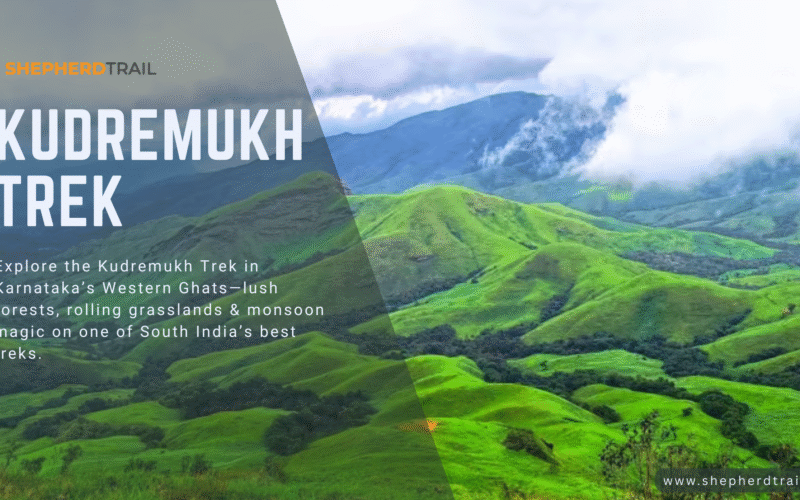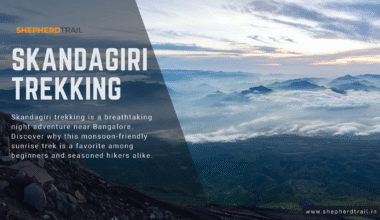Kudremukh Trek: A Walk Through the Western Ghats’ Emerald Crown
Where the trails echo with mist, hooves, and heritage
Introduction: A Trail That Whispers Ancient Stories
In the heart of Karnataka’s Chikkamagaluru district lies a mystical land where clouds roll like waves across mountain meadows, where the monsoon breathes life into dense shola forests, and where peaks form the silhouette of a horse’s face—Kudremukh, which in Kannada literally means Horse Face.
This isn’t just another Western Ghats trek. Kudremukh is a tale of ecological richness, a sanctuary for endangered species, and a trail that invites you to witness nature in its most untamed elegance. Whether you’re a seasoned trekker or someone seeking their first long walk into the green wild, Kudremukh speaks to the soul.
Trek at a Glance
- Location: Kudremukh National Park, Chikkamagaluru, Karnataka
- Altitude: 1,894 meters (6,214 ft) above sea level
- Trek Distance: ~20 km (to and fro)
- Duration: 1 day (moderate pace)
- Difficulty: Moderate
- Best Time to Visit: June to February (monsoon and post-monsoon are magical)
- Trail Type: Out-and-back trail through forests, meadows, and streams
- Permit Required: Yes (issued by Kudremukh Forest Office at Mullodi)
- Camping: Not allowed inside the national park; stay at Mullodi homestays
The ShepherdTrail Perspective: Why Kudremukh Matters
We’ve walked many paths across the Himalayas and the Western Ghats, but Kudremukh holds a sacred blend of biodiversity and simplicity that feels personal. Here, the trail isn’t just about reaching a summit—it’s about listening to forest rustles, slipping your shoes off to wade through knee-deep streams, and catching a glimpse of a sambar deer peeking through bamboo groves.
Kudremukh isn’t just a mountain. It’s an experience. A trail that gently tests your limits and deeply rewards your senses.
Scenic Highlights That Define the Trail
🌿 The Shola Forests
The first stretch of the trek winds through thick shola forest—a biodiversity hotspot unique to the Western Ghats. Moist, dark, and alive with sound, these forests cradle countless endemic species. Leeches tag along during the monsoon, but that’s part of the fun.
The smell of wet earth and the calls of malabar whistling thrushes become your walking companions.
🐎 The Horse-Faced Peak
Around 3 hours into your ascent, the dense forest parts ways to reveal Kudremukh’s defining feature—a mountain ridge shaped unmistakably like a horse’s face. It’s a sight that stops you mid-step.
On misty days, it appears like a silhouette; on clear days, its sharp features carve the sky.
🏞️ Rolling Grasslands and Hidden Streams
Beyond the tree line, you step into a surreal landscape—moss-laden slopes, wild orchids, open grasslands, and streams that snake silently across your path. Monsoon transforms this stretch into an emerald canvas.
If you’re lucky, clouds will chase your shadow and play hide and seek with the sun as you walk.
📸 The Final Push and the Summit View
The last 1 km is the most strenuous—but the summit gifts you panoramic views of the Arabian Sea (on clear days), the Kudremukh ranges, and deep valleys stitched with streams. You don’t just see landscapes—you feel them.
Sit, breathe, and soak in the silence.
Why Kudremukh Trek is a Monsoon Marvel
During the monsoon months (June–September), Kudremukh turns into a living postcard. While many treks close due to landslides, Kudremukh remains accessible with local forest permission and offers one of the safest and most soul-stirring monsoon treks in India.
Here’s why monsoon enhances the experience:
- Lush Greenery: The grasslands glow a neon green, impossible to replicate outside this season.
- Waterfalls Emerge: Seasonal waterfalls and streams surge to life, making the trail feel enchanted.
- Cloud Drama: With every ridge you cross, the mist rolls over like waves in a quiet storm.
- Biodiversity Bloom: Wild mushrooms, frogs, and insects emerge, showcasing nature’s intricate designs.
It’s wet, yes. It’s leech-prone, sure. But it’s also unforgettable.
DIY Trek Itinerary: Conquer Kudremukh on Your Own Terms
The Kudremukh Trek isn’t just a walk through the Western Ghats—it’s a personal dialogue with misty grasslands, dripping canopies, and mountain winds that whisper stories from centuries past. If you’re the kind of trekker who likes to take the trail into your own hands, here’s how to experience Kudremukh step by step—without losing its spirit.
Day Before the Trek – Arrive and Acclimatize
-
Where to Reach: Mullodi Village, Chikmagalur district, Karnataka
-
How to Get There: Reach Kalasa town by bus or car. From Kalasa, local jeeps take you up the off-road trail to Mullodi (around ₹600–800 for the full jeep).
-
Stay the Night: Choose a local homestay—most are simple, clean, and offer food + forest permit assistance.
-
Things to Confirm:
-
Your forest permit for the trek
-
Local guide (mandatory per forest department rules)
-
Packed breakfast and water bottle refills
-
Weather forecast (especially in monsoon)
-
Your Trek Day: Solo but Rooted in Tradition
⏰ 5:00 AM – Wake Up at Mullodi Village
The hills wake up slowly. So should you.
Step out into the cool air. Sip a cup of steaming filter coffee while the forest mist rises like incense from the valleys. Use this quiet time to stretch, hydrate, and mentally prepare for the day. This is where your journey begins—humble, mindful, and honest.
🥾 6:00 AM – Begin the Trek
Your local guide will lead you into the trail after your forest permit check.
The initial stretch climbs gradually, weaving past coffee plantations and whispering bamboo clusters. The sun hasn’t fully claimed the sky yet, but the jungle knows you’re here.
Walk with intention. Breathe with rhythm. Let the trail introduce itself to you—one step at a time.
🌳 7:30 AM – Enter the Forest Section
As you climb, the trail changes character.
Now you’re beneath a dense canopy. Rain-drenched leaves glisten. Tree roots twist like veins across your path. You’ll cross gurgling streams—remove your shoes or leap with faith.
This stretch is a birder’s paradise. If you walk in silence, you may hear the Malabar whistling thrush or even catch a flash of a hornbill.
🌿 9:00 AM – Grasslands and Open Skies
Suddenly, the trees part. You’re out in the open now—rolling meadows stretch before you like green ocean waves.
The wind here speaks differently. It carries the scent of wet grass and distant clouds. The peak of Kudremukh stands ahead, proud and aloof, shaped like the head of a horse.
This is a good place to pause. Sip water. Eat your packed breakfast. Feel the landscape open your lungs and your heart.
🏔️ 11:00 AM – Reach the Kudremukh Peak (1892 m)
And here you are.
You’ve walked roughly 9 km through forest, mud, mist, and meadow to stand on one of Karnataka’s most iconic summits.
Let the world go quiet now.
Sit. Breathe. Journal your thoughts if you wish—or simply listen to the wind.
Take photographs, yes—but not so many that you forget what the sky smelled like.
🕛 12:00 PM – Begin Your Descent
The mountain gave you a view. It also asks for your respect.
Begin descending no later than noon. Afternoon rains sweep in fast, and trails can turn into slippery ribbons of clay and moss. Take steady steps, and let your guide help pace your return.
⛺ 3:00 PM – Return to Mullodi Village
You’ll arrive back at your homestay by mid-afternoon—muddy, tired, and full of mountain memories.
Warm food awaits—typically a plate of rice, sambar, local vegetables, and maybe even a sweet dish if your host is feeling generous.
Take a nap or just sit outside with another cup of coffee. Watch the clouds roll back in.
You’ve earned this moment.
Essential Tips for Your DIY Kudremukh Trek
-
Permits: Required. Your homestay can arrange this. Only 50 trekkers are allowed per day (on average), so book early.
-
Guide: Compulsory as per forest rules. Usually arranged by homestays (approx. ₹600–800 per group).
-
Best Season:
-
Monsoon (June–September): Lush, misty, and magical—but expect heavy rain and leeches.
-
Post-Monsoon (October–February): Clear views, crisp air, and golden grasslands.
-
-
Difficulty: Moderate. Around 18 km round trip with steady inclines.
Homestay Hospitality: Mullodi’s Warm Embrace
Staying in Mullodi is not just convenient—it’s part of the journey. Most homestays here are run by local families who offer:
- Simple but delicious food (think rice, sambar, chutney, eggs)
- Warm beds and clean washrooms
- Arranged guides and permits
- Hot water and ever-flowing coffee
This is a rare instance where your base village is as calming as the trek itself.
Essential Trekking Gear for Kudremukh
Here’s what we carry on every Kudremukh trek:
- Waterproof hiking shoes (with good grip)
- Light poncho or rain jacket (monsoon essential)
- Quick-dry trekking pants and t-shirt
- Daypack with rain cover
- Water bottles (2L minimum)
- Electrolyte sachets / ORS
- Energy bars and trail snacks
- Basic first aid kit (with leech repellent or salt)
- Headlamp or torch (just in case)
- Camera (but carry it light)
For a complete monsoon gear checklist, check our “Gear We Use” series on ShepherdTrail.
Responsible Trekking in Kudremukh
Kudremukh is part of a protected national park—home to tigers, leopards, civets, and the endangered lion-tailed macaque. It’s crucial we trek responsibly:
- No plastic: Bring it back if you carry it in.
- Stay on the trail: Straying can harm flora and disturb wildlife.
- No camping or bonfires: Strictly prohibited inside park boundaries.
- Hire local guides: Not just for safety, but to support the community.
- Respect silence: Loud music, shouting, or drones are a big no.
- Don’t feed animals: Ever.
Spiritual Connection: Listening to the Land
You’ll hear no bells on this trail. No chants echo from the summit. But make no mistake—this is a sacred path. Sacred not because humans assigned it so, but because nature reigns here in full glory.
Walking Kudremukh is like walking through a live prayer—where every raindrop, chirp, and breeze aligns you with something far greater than yourself.
For us at ShepherdTrail, it’s not just a trek. It’s a reminder of how wild and gentle the world can be at once.
Final Thoughts: Should You Do the Kudremukh Trek?
If you:
- Love dramatic cloudscapes and rolling green meadows
- Can handle a moderately long day trek (~20 km)
- Are curious about Western Ghats ecology
- Want a quieter, less commercial experience
- Respect nature and walk with humility
Then Kudremukh is calling you. And we say—answer that call.
More From ShepherdTrail
If Kudremukh inspires you, you might also enjoy:
- Ettina Bhuja: A lesser-known monsoon marvel
- Tadiandamol: Coorg’s highest peak
- Valley of Flowers: For those who want Himalayas in bloom
- Pin Bhaba Pass: A Himalayan cross-over trek of contrasts






